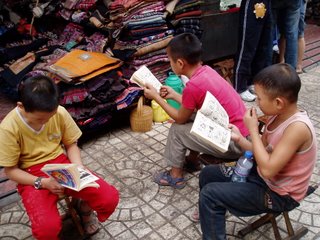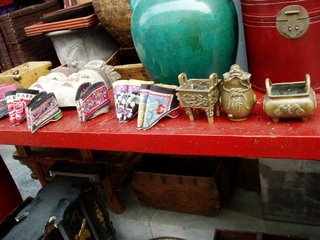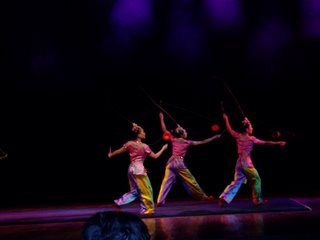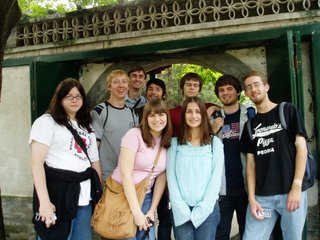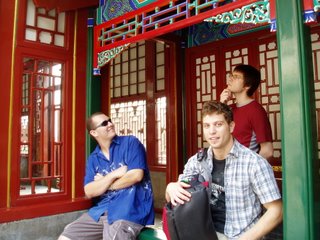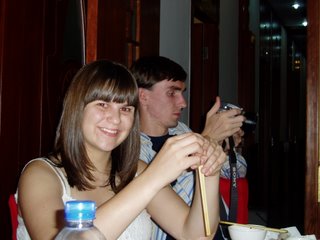Saturday, September 30, 2006
Chen Yaping

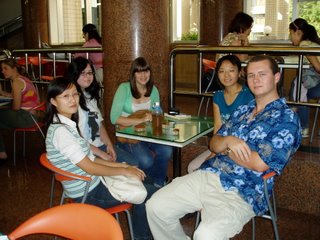

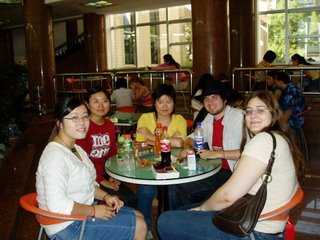 Top: Jackie, Aaron, Tim and a Chinese guest
Top: Jackie, Aaron, Tim and a Chinese guestSecond: Vicky, Ashley, Forrest, and two Chinese students
Third: Parker, Sean, Professor Chen (standing), and one of her students
Bottom: Chinese students and Erik and Natalia
Although we are surrounded by Beijing, in our dorm the people we see most of the time are other foreign students, primarily from Europe, Japan, and Korea. We need to speak Chinese to people who can determine if we're pronouncing things properly, and students of English need native English speakers to practice with as well. My former colleague at North Central, whom I knew there as Yaping Chen, is the person who began the contact between North Central and Beijing Foreign Studies University. She and I used to see quite a lot of one another in Naperville, and it's a treat to see her here in Beijing. She was kind enough to bring mooncakes in different flavors in celebration of the upcoming National Holiday that begins on Sunday, October 1, and lasts a week.
Dumplings = Baozi

Dumplings are a favorite quick meal or snack in China. There are two main types here: jaozi and baozi. One is boiled, and the other steamed. The boiled ones we know in the U.S. as potstickers, especially if they are fried after boiling. Both seem to have similar fillings of chopped pork and seasonings. The steamed dumplings are not unlike the dumplings that my mother used to cook on top of a beef stew, at least on the outside. Beijing is wheat rather than rice country and there are plenty of bread products on the store shelves and in the dining hall. This is the first Pepsi I've seen in a while. The pitcher contains dark vinegar, which is used as a dipping sauce rather than soy. (I will say that the plain vinegar is not as good as the secret sauce served with potstickers at Taste of China on Rte. 59 & 95th St. in Naperville.) The dumplings here sit on top of a bamboo steamer. One order is enough for two people.
Wednesday, September 27, 2006
We Try to Paint

Parker and Erik: Parker's mustache is real, despite the pose. I think the crab Erik is holding was painted by Du Laoshi. Parker and Erik are studying second year Chinese and often are called on to interpret. UPDATE: Whoops, I was wrong. This is Erik's own painting. Nice job, Erik!
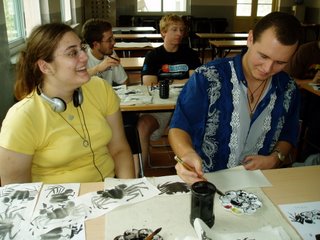 Natalia and Forrest enjoying the painting lesson. Natalia and Forrest have both studied Japanese for many years and are expert at the stroke order I find so difficult! You can see Jim and Jeff in the background.
Natalia and Forrest enjoying the painting lesson. Natalia and Forrest have both studied Japanese for many years and are expert at the stroke order I find so difficult! You can see Jim and Jeff in the background.
Du Laoshi (Professor Du) taught us how to paint today, and we got to imitate the watercolor crabs he had painted yesterday. In writing Chinese or Japanese characters, stroke order is important (something I'm not very good at remembering!) And in teaching us how to paint the crab, Du Laoshi showed us a diagram with a stroke order for creating the crab, similar to stroke order for a Chinese character. Three broad short strokes for the body: middle, left, right. Yi, er, san - one, two, three. Short strokes for the claws at the top: left, right. Four straight lines tipped upward for the legs: yi, er, san, si, on the left then on the right. Four more lines on each side for the lower part of the legs. Dip the brush back in the paint for the claw tips: yi, er, san, si, wu, liu, qi, ba. Close the claws at the top, and add the eyes.
Chinese Painting

 Top: Du Zhenglin and our group: Top row: Forrest, Jeff, Parker, Prof. Du, Vicky, Ashley, Erik, Sean; Middle row: Judy, Jackie. Bottom row: Natalia, Jim, Tim, Aaron. We're standing in front of one of Prof. Du's paintings.
Top: Du Zhenglin and our group: Top row: Forrest, Jeff, Parker, Prof. Du, Vicky, Ashley, Erik, Sean; Middle row: Judy, Jackie. Bottom row: Natalia, Jim, Tim, Aaron. We're standing in front of one of Prof. Du's paintings.Next photo: Prof. Du and the quickly-painted crabs
We had our first session last night with Du Zhenglin, an artist and art professor at Beiwei, who holds a number of other titles, including Director of the China Painters and Calligraphers Association and President of the BFSU Painting and Calligraphy Association. He only speaks a little English, and only three of our students have had a year of Chinese. (The rest of us are beginners.) We managed to figure out most of what he was demonstrating, including showing us the different brushes used in Chinese painting. We watched as he expertly used a few strokes in black watercolor to paint crabs scuttling along underwater. We walked with him around the campus in the dark as he pointed out examples of calligraphy he had designed for the University, including the characters on many of the buildings and the entrance to the East Campus. He took us to an art exhibition on our side of the campus produced by students, faculty, and retired faculty, recruiting an English-speaking student to translate. When we stopped at his office he handed out lovely brochures featuring examples of his work, and we recognized a group photo from the back inside cover: Heather Coon and some of her students who were at Beiwei two years ago! Today we're going back to his classroom - to paint!
Monday, September 25, 2006
More Television Tales
 December, 2005 - The Medina (walled city) in Fez, Morocco - the medina in Fez dates back to the 9th century, and is a rabbit warren for the foreigner. In many ways it's a living medieval city, and some people who work as tailors or bakers or shopkeepers live the same way they have for a thousand years. But notice the satellite dishes!
December, 2005 - The Medina (walled city) in Fez, Morocco - the medina in Fez dates back to the 9th century, and is a rabbit warren for the foreigner. In many ways it's a living medieval city, and some people who work as tailors or bakers or shopkeepers live the same way they have for a thousand years. But notice the satellite dishes!In addition to seeing Seinfeld and Larry King in China, I’ve also seen those shows in Cuba, of all places. In Rabat (Morocco), this past winter, where the hotel was very comfortable and we had a huge room, roommate Dee Wiedeman and I watched the old Cary Grant-Audrey Hepburn movie Charade dubbed into French. I think Audrey did her own French dubbing, but whoever did Cary’s voice sounded nothing like him, which was a little disconcerting. We tried to watch Al Jazeera, but that was only in Arabic, which we couldn’t understand. Educated people in Morocco speak beautiful Arabic, French, English, and sometimes a Berber language, like Tazrit; using each language has its own political and practical implications. People speak CMA (Common Moroccan Arabic) at home, learn classical Arabic in school, French in elementary school and English in middle or high school. The Berber languages are a recent addition to the Moroccan curriculum, and they have their own writing system, distinct from Arabic or Roman script. One of the lecturers we heard suggested that the new generation of female Moroccan authors sometimes preferred to write in French, men in Arabic. I was using my ancient but serviceable college French in Morocco and only had a few words in Arabic. At the Hotel Olympique in Fez, our first overnight stop in Morocco, the keys stayed at the front desk, since they were attached to heavy nickel weights the size and shape of antique silver salt shakers. A few of the men at the front desk insisted we claim our room keys by saying the room number in Arabic. When we complained at the Hotel Olympique that there was no remote for the TV (it was mounted high enough that you needed a chair to get to it) the manager shrugged and said, “There are only two channels anyway.” The phone, the heat, and the shower didn’t operate either, but he insisted the phone worked, banging the receiver up and down. “See? Just do this.” Whack, whack. We told him it was cold. He countered cheerfully: “It’s fine!” He solved the problem by moving us to the next room, where the phone, heat, and shower were all in working order. We managed to climb up and turn on the TV and listen to it in French. I gave the room number in French the rest of the time we were in Fez.
Television in Beijing
Oprah
Seinfeld
The Bold and the Beautiful
Two and a Half Men
Larry King (today’s guest was former N.J. Governor McGreevey)
Entourage
Cops (last night’s episode was from Jersey City, N.J.)
There’s a compilation version of Jon Stewart's Daily Show, but I’ve never caught it. At least Stewart, who is from Union, New Jersey, would improve the image of my home state being projected this week in Beijing. It's hard to tell how old most of the shows are, but they are not particularly current.
Shows that will be starting soon on Channel 80:
Hope and Faith
According to Jim
Everybody Loves Raymond
As you can tell, I have cable. There are channels in Chinese, Thai, English, German, French, and an English-language Korean station. (The German station also uses about half English and half German). The Chinese channels tend to be quite serious, and CCTV 9 has a very good analysis and interview show called Dialogue whose host speaks impeccable British-accented English. That station also has an excellent language program called Travel in China with a Canadian host with daily lessons in Chinese for English-speakers. CNN is the international version from Hong Kong, and HBO may be from Singapore. The latter is laundered of most profanity. Channel 80 on my cable is “Starworld,” which has an eclectic mix of American shows with a few British ones tossed in.
Sunday, September 24, 2006
Ephemera from the Cultural Revolution
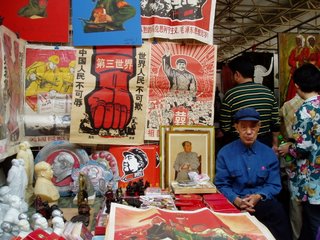
"Ephemera" is the term antique dealers use for paper goods, including sheet music, dress patterns, magazines, and newspapers. It seems inadequate for the posters and other printed material people now collect from the era of the Cultural Revolution. Some of those collectibles have become kitschy, including some of the posters. Other remnants are more evocative. You can find both at Panjiayuan.
Panjiayuan - The Flea Market
On the southeast side of the city, diagonally opposite to the northwest quadrant where we live, is the famous Panjiayuan Market. It's held only on Saturdays and Sundays, and people who are organized get there early. It's a slice of Chinese life, filled with Beijingers as well as tourists. The locals outnumber the tourists (at least the western tourists), which always makes for an experience that feels more authentic (Fussell writes a lot about what is touristy and what is not: I'm not sure what he'd make of this market.) It is laid out not unlike a flea market in the U.S., in squares and rectangles, and easy to find your way around. Some of the shops are handsome and permanent, selling fine jewelry and expensive antiques. Some of the goods are on tables, and others laid out on the ground. I wanted to see a Chinese person bargain, so tried to be unobtrusive as I watched a woman comparing a new jade bracelet to the one she already owned, The vendor used a glass bar the size of a piece of chalk and tapped on the jade so that it made a satisfying ring, but still no sale. My companions for the day were looking for small porcelain dishes, a scroll, an abacus, and a rolling pin made out of fine wood, and of course they found everything. The professor who wanted the rolling pin is Italian and was going to use it for pizza dough although the Chinese ones are for dumplings. But what I was looking for was historical ephemera - posters or other documents from the Cultural Revolution, something that has become very marketable. I was not disappointed. I'm having some trouble uploading photos, but I'm going to try again to get more on the next post. Any hints about uploading photos? For some reason I can do them from my camera directly from the memory card, but not from my saved files.
For My Gourmet Club Friends



I know it seems as though food is one of the main subjects of this blog, but it's unavoidable in China. Food is taken seriously here: everyone cares about food, is proud of local specialties, cooks, eats out, and eats together. Tonight, if I were home, I would be attending the first fall gathering of the Gourmet Club that my husband and I belong to. My husband will be there tonight at the September Wine and Cheese gathering. So - this is for you, fellow Gourmet Club members! The Club began as a typical midwestern organization in our Naperville neighborhood, Over the years many of the members have moved to other parts of town but stayed part of the club, Some have moved to other cities and returned; one couple has even moved to another country and then returned! We're not really gourmets, but we like to get together, share recipes, and have a good time without spending a lot of money. I've always said it should be the We'll Try Anything Once Club. We plan the entire year's menus during the summer, and share the hosting of six full dinners between October and June. Gary and I will be making Moroccan food this spring for the group.
In China, the dishes even at inexpensive restaurants are excellent, especially those that serve primarily local people. Tonight I went out to dinner with three Europeans who are here with some students. We began at Beihai (literally North Lake) Park, not far from the Forbidden City, which features a huge tower, the White Dagoba, quite unusual in comparison to most structures in Beijing:the Insight City Guide: Beijing describes it as "an onion-shaped shrine in the Tibetan style, built on the ruins of a Ming palace in honour of the fifth dalai Lama on the occasion of his visit to Beijing in 1651" (123), and notes that the lake in the center of Beijing was split into two in the 15th century(121), and Beihai is built around the northern lake. In the winter, "[in] days gone by, the ice was smoothed with glowing irons for imperial celebrations" (121). People still skate on it in the winter. But it was hot and steamy today, and we were happy to see a red sun beginning to set in the west as we walked around the park, which, like so many public locations in Beijing, is undergoing renovation in preparation for the 2008 Olympics. We took at look at the famous Fangshan Restaurant in the park, begun by three imperial chefs after the dissolution of the monarchy, which features elaborate gold-leaf walls, painted ceilings, and an antique sedan chair. But it was going to be at least 200 yuan (RMB) for dinner (about $25) which is an almost scandalous price in China for a savvy traveler.
We opted instead to take a cab to a restaurant my companions had been to before, one that was clearly a local favorite, full of families and groups of friends, smoking and eating and having a good time. Peking duck was one of the offerings, but we opted for Mandarin fish, You can see that it is spread open and presented almost in the shape of a Blooming Onion. There are no bones, making it quite easy to pull apart and eat with chopsticks. Before Mr. Fish appeared this way the waiter brought an orange plastic pail to the table - as we looked down we realized it was a live fish, gills still flapping, delivered to demonstrate its size and freshness.
Saturday, September 23, 2006
The Dining Hall
 This is what I had for lunch yesterday: chicken, rice, and a steamed vegetable that I think is bok choy or something like it. It's a little easier for westerners because it usually doesn't have bones, so the problem of what to do with bones in your mouth is eliminated. Note that it's served with a spoon as well as chopsticks; some people hold them at the bottom of the chopsticks to keep things from falling. I think but I'm not sure it's considered something kids do, or girls being careful about not spilling. The dining halls use no napkins: theoretically nothing touches your fingers so you shouldn't be getting your hands dirty. There is a set of sinks just behind where the students are sitting in the photo below, so it's easy to wash your hands before or after lunch. The water - "Ice Dew" - is bottled by Coca Cola. There is no sugar-free cola here (or most places outside the U.S. I've traveled to) but there is often a Coke Light. Those over forty-five will recognize the pop-top - that removable metal tab that can cut your fingers. There's another brand of water called "Wahaha" - the sound of laughing. At the school's convenience store it costs 2 kuai (2 yuan), about a quarter. Coke is three yuan.
This is what I had for lunch yesterday: chicken, rice, and a steamed vegetable that I think is bok choy or something like it. It's a little easier for westerners because it usually doesn't have bones, so the problem of what to do with bones in your mouth is eliminated. Note that it's served with a spoon as well as chopsticks; some people hold them at the bottom of the chopsticks to keep things from falling. I think but I'm not sure it's considered something kids do, or girls being careful about not spilling. The dining halls use no napkins: theoretically nothing touches your fingers so you shouldn't be getting your hands dirty. There is a set of sinks just behind where the students are sitting in the photo below, so it's easy to wash your hands before or after lunch. The water - "Ice Dew" - is bottled by Coca Cola. There is no sugar-free cola here (or most places outside the U.S. I've traveled to) but there is often a Coke Light. Those over forty-five will recognize the pop-top - that removable metal tab that can cut your fingers. There's another brand of water called "Wahaha" - the sound of laughing. At the school's convenience store it costs 2 kuai (2 yuan), about a quarter. Coke is three yuan.
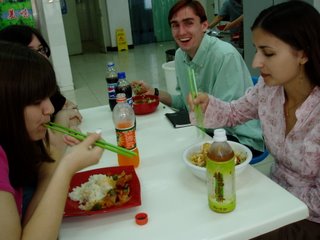 Ashley, Vicky (partially hidden), Tim, and Jackie eating lunch at the dining hall. Jackie's eating noodles topped by a fried egg. Many of us have also become fond of the milk tea (nai cha), which comes in many flavors, including coffee, fruit flavors, and something that tastes just like birthday cake. By the way - although we are all taking Chinese, everyone at this table has also studied Japanese, and Tim and Vicky have made short visits to Japan before. Jackie has also completed majors in French and German.
Ashley, Vicky (partially hidden), Tim, and Jackie eating lunch at the dining hall. Jackie's eating noodles topped by a fried egg. Many of us have also become fond of the milk tea (nai cha), which comes in many flavors, including coffee, fruit flavors, and something that tastes just like birthday cake. By the way - although we are all taking Chinese, everyone at this table has also studied Japanese, and Tim and Vicky have made short visits to Japan before. Jackie has also completed majors in French and German.
Friday, September 22, 2006
Shopping, Massage, and Pineapple Rice

Yesterday I went to a Chinese wholesale market with a new Chinese friend, a lovely woman who had been friends with Heather Coon when she was here two years ago. When we got to the wholesale market I think I was the only westerner in a huge building with thousands of individual kiosks divided into four floors. Stall after stall of housewares were featured on one floor; leathergoods on another; underwear and pajamas on a third; jewelry on a fourth. In an adjacent building, there was a floor of stationery products, another of shoes, another of silk scarves and pashminas. No space goes unused in Beijing: people even sold hats and small purses on the overpass and one woman had a box of tiny live birds for sale, no bigger than walnuts. According to my new friend, most of the people who own the kiosks at the wholesale market are from a town near Shanghai that is also her home town. They speak a different dialect than Mandarin, and she spoke in that dialect to all the vendors she knew and some she didn't. In China you can bargain for almost any purchase, except in stores with fixed prices, and of course local people get a better deal than foreigners. According to her (and I don't doubt it) people who speak the shopkeepers' dialect get the best deal of all. I bought some decorative pillow covers, China T-shirts, and a hair dryer at prices that seemed exceptionally reasonable. Then we went to a salon for a foot massage. I also opted for a neck and back massage that included having someone (a lightweight woman) walk on your back as she supported herself on bars that resembled the frame for a canopy over a bed. All I can say is ....OUCH! It was pretty vigorous (lots of twisting of shoulders and knees) but the back-walking was reasonably comfortable although I should check for footprints. The foot massage, which starts with your feeting soaking in wooden tub of hot, hot water mixed with some powdered tea, is more my speed. At the end of the day Heather's friend took me to a place that the students who have gone on this trip before will recognize: Dai Ethnic Restaurant, serving food from a province that borders Southeast Asia (Yunnan). It's a storefront, not too big, but quite popular and we had to take a number. The back wall features an enlarged photo of the owner, young and handsome, smiling broadly as he shakes the hand of Chou En-Lai, welcoming him to his province; now fifty years older but very successful, the owner usually sits behind the cash register. We ate pineapple rice, hot rice mixed with fresh cooked pineapple served in the hollowed-out shell; a hot-pot style chicken soup with long, soft rice noodles and fresh herbs, and a medium-spicy chicken dish with chilis and chopped green and red peppers. I drank coke (ke le) and we both drank hot tea; I seem to need twice as much liquid per meal as any Chinese person because I love spicy dishes but need to cool them down. Then we walked back to the dorm and she rode off on her bicycle into the night.
Wednesday, September 20, 2006
A Banquet in China
 Above: The Beiwei Hotel, adjacent to the campus; you can see just a bit of the photo of the huge cooked chicken on the left side of the overhang advertising its excellent restaurant.
Above: The Beiwei Hotel, adjacent to the campus; you can see just a bit of the photo of the huge cooked chicken on the left side of the overhang advertising its excellent restaurant.One of the continuing topics we're discussing in China is "culture shock" or how to deal with intercultural surprises. In preparation for that, the students have read Encountering the Chinese, a guide for people studying and doing business in China. I recommend it: it's well-written and has footnotes that are as interesting as the text. North Central has been using it regularly for students going to China.
On Tuesday I was fortunate enough to be invited to my first Chinese banquet - a luncheon for one of my favorite academics, Dr. Roger Ames. Roger is a professor of philosophy at the University of Hawaii, a director of the Asian Studies Development Program at the East-West Center, and a renowned expert on Confucianism - so expert that he also teaches at Peking University, and was asked by Beiwei (our college here in Beijing) to teach a class on Chinese philosophy. Among his thirteen or so books are his translations of the Analects of Confucius and the Daodeching. The president of Beiwai was a student of Roger's at the University of Hawaii many years ago. I have been fortunate enough to attend two three-week ASDP seminars, one on Southeast Asia and one on China. I also brought Roger to NCC to speak on Confucianism a few years ago. Our class of NCC students here at Beiwei happened to attend a lecture a few days ago by another distinguished member of the faculty who spoke to us about Confucianism and Daoism; at the end of the lecture I asked if he knew Roger. Not only did he know him - he was hosting a luncheon for him the next day and invited me on the spot. Not only was I honored - I was a little overwhelmed. Was this the sort of invitation I should say yes to immediately, or was it just a polite gesture? Wouldn't it be hard to add another person at the last minute? The trouble with trying to remember your intercultural training is that you don't have the book in front of you when the occasion arises.
In any case, I said yes, remembering at least that last-minute invitations to events like that are not unusual and should be heeded. I knew that the Beiwai Hotel was quite fancy, and the restaurant on the second floor well-known for its delicious food. A huge sign on the building displays a large cooked chicken; when I saw it this summer I was puzzled, but arriving at the restaurant I realized the restaurant had a chicken theme when I saw a person-sized statue of a chicken on the second floor.
The professor who had given our lecture had written instructions in Chinese for me so that the staff would direct me to the right place. Almost everyone was already seated in the private room; I'll have to remember to come early if I get invited again to a banquet. The president of the university sat to Roger's left; to the left of the president the dean who had been our lecturer; I was seated at Roger's right. At that point I started to feel like an imposter: perhaps I had overstated my relationship? Seating at a banquet is a serious business. The professor to my right translated for me, because almost all of the conversation was in Chinese. I have heard enough Chinese now to recognize Roger's Vancouver accent in his perfect and idiomatic Chinese (I know it's idiomatic because his lectures often includes explanations of Chinese phrases). The president of the university, clearly very fond of Roger, told stories about his days as a student at the University of Hawaii. While my companion to the right (a dean and professor of English) was translating, she was also serving me from the dishes on the huge glass lazy susan that took up a large part of the round table. The food was exquisite: tiny salty shrimp in their shells, to be eaten whole; a purple eggplant dish with garlic; wonton purses filled with chopped seafood and tied with scallions; pumpkin soup; a molded vegetable pate; a dish of fresh mango and cashews; chopped garlicky fish in its skin; soft pine nut cookies; small pastries flavored with cocoanut and filled with beanpaste; beer, wine, juice, and hot tea. The waitresses made sure the glasses were always full; my seatmate made sure I always had something to eat; I tried to behave myself.
It's important at a Chinese banquet to keep up with the toasts. Hu Wenzong and Cornelius Grove, editors of Encountering the Chinese, remind us that you must toast, although it doesn't have to be with beer or alcohol. Although the famous "thimble-sized" glasses were on the table at the outset, I don't think anyone drank maotai, the fiery clear Chinese alcohol. I alternated toasting with beer and tomato juice. Not only that: there is a specific way to clink the glasses together. Out of modesty, my hostess to the right explained, you try to put your own glass lower than that of the person you are cheering if he or she is older, or the distinguished guest, or of a higher rank. Ah, I had forgotten that. I hoped they would forgive me. Roger and the president engaged in a little contest of toasting, each trying to get lower than the other.
At the end of the banquet, as Hu and Grove write, the host gets up and everyone leaves at the same time - quite "abruptly, by American standards." Just as they said, the president of Beiwei looked at his watch (Roger's lecture was to begin shortly), and everyone left. In fact, they started leaving almost too soon to distribute the gifts the staff or faculty members had wrapped. I wish I had taken a photo (I thought it might be too forward) when they realized they had forgotten to take one. And they gave me a gift as well, which I knew not to open on the spot. I waited until my class to open it in front of the students: it's a beautiful yellow silk scarf.
Tuesday, September 19, 2006
The Paper Journal

Here's a photo of my paper journal - which I'm keeping simultaneously with a blog. But I have never been very faithful to paper journals - somehow they remind me of diaries I kept when I was ten - for a week or two. I am determined to do better. Isn't it pretty? It was given to me for my birthday last year by the wonderful secretary for the NCC English Dept., Peggy Geffinger. It's sparkly and textured and very Asian-looking. During the first week or so, when it was hard to get online, I appreciated the value of a paper-based journal: it's portable; you can write in it at any time; you can collect ephemera (tickets, receipts, business cards); it's as low-tech as it can get. You don't need electricity or a computer or a camera, just a pencil or pen. And of course, unless you choose to share it, it's private, quite the opposite of a blog. Some of the students are keeping journals in multiple formats, both paper- and electronically-based. The students have been contemplating the argument Fussell makes in his 1980 book Abroad about the replacement of travel with tourism, which he illustrates with examples from a golden age of British travel writing in the Interwar years. This week Ashley wrote,"According to Fussell, a tourist doesn’t brave hardship; instead he avoids it at high costs. All of this is a bold and rather logical argument when one is caught up in the reading of Abroad but further and independent contemplation can lead to some radically different conclusions. It seems to me that Fussell pines for days long past and his argument against tourism is not entirely useful. The real distinction between travel and tourism lies only in the mind of the traveler." Tim, writing about whether or not preferring "travel" to "tourism" is a kind of snobbery, found a quotation from Fussell he appreciated: “These people [like Hemingway, James Joyce, and D.H. Lawrence] made their money take them very far, less because they were equipped with capital than because they were equipped with intelligence, energy, and curiosity.” Hemingway is of course American and Joyce Irish, but they were among the expatriates who found Paris in the 1920s cheap as well as intellectually and artistically nourishing.
Monday, September 18, 2006
Don't Do This
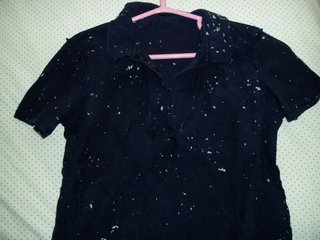
Hmmm...I have been doing laundry for perhaps - forty years? This is what happens if you leave a tissue in your pocket. I think my mother told me not to do this in about 1966. No dryers here, so you can either shake it out or wash it again. I vote for washing it again. The little bits of tissue are remarkably evenly distributed on this navy-blue polo shirt.
Laundry List
 Photo above: a laundry tub in Granada, Nicaragua, December 2004
Photo above: a laundry tub in Granada, Nicaragua, December 2004One of the questions students always have when they arrive at a dorm is how to do the laundry, and a good thing, too. Every country has its own laundry mysteries. In Nicaragua the home four of us stayed in on an Interim trip in 2004 - a house so enormous that it was built around several courtyards that took up almost a block - so big that they rented out office space by opening exterior doors on the street - so big it held enough furniture for twenty families - a maid did the laundry by hand in a stone tub. She then strung it on crisscrossed lines in the courtyard while chickens clucked beneath. (And that's what we had for breakfast, cooked by another servant: the eggs from those chickens.)
Although one of the texts we are using for the Culture Class, "Encountering the Chinese," notes that Chinese students often live five or six to a room in a space the size of "a large pantry," and sleep stacked in bunks The authors also explain that Chinese college students often have to haul the water to do their laundry by hand, carry their own dishes to the dining hall, and wash them afterwards. In comparison to that we are not roughing it. (The students here do not have to wash their own dishes, although you often see students carrying large thermoses that they fill with boiling water and use for tea and ramen-style noodles. I assume they have washing machines in the Chinese students' dorms here, but I don't know that for a fact.) We have washing machines on our floors, which is extremely convenient. Here's how it works: buy a 50 RMB (50 yuan) magnet, shaped like a flat ice cream cone, at the front desk. Get yourself some detergent and some plastic hangers at a market or the convenience store. Put a small load of clothes in the tub (the top folds back to open), add about a cup of detergent, and hold the magnet on a green spot on the dashboard of the washing machine. After about five seconds, the machine will start, and it takes about 40 minutes for a load to finish. A dorm room for foreign students may come supplied with some kind of clothesline or rod; in some student people hang them out the window on racks. My room has a fancy arrangement with a rod that I can raise and lower to take advantage of the breeze from the window or move out of sight when I'm done hanging my laundry. In this lovely dry season it dries pretty quickly, usually overnight.
Sunday, September 17, 2006
The Stairway to Love


Despite a name that sounds slightly disreputable in English, the Stairway to Love is our local and thoroughly respectable internet cafe. It is on the Third Ring Road, just to the right (north) of the West Campus of Beiwai (BFSU), a relatively short walk from our dorm . A sign outside displays a photo of a pizza and advertises "Free Internet." Above the actual stairway is a sign in cursive Roman alphabet displaying the "Stairway to Love" sign. The cafe features comfortable red armchairs, small tables and table lamps, and lots of electrical outlets, useful for recharging when your laptop battery goes out. There is an Internet room in our dormitory, run by an outside company that charges but is quite cheap as those places go - if I go there I usually spend about a dollar for my long session. But if you have a laptop, or you can share one with a friend, this is great. The Internet is free, but you are expected to order something to drink or eat. The food is excellent, and though the prices are close to western-level (for instance, a little less than two dollars - 15 yuan - for a bowl of creamy and slightly peppery potato-cucumber soup, as opposed to six yuan in the dining hall for a generous plate of rice and two meat/vegetable entrees) it's a treat. You can stay for quite a while if you wish, even without ordering additional food, and the wireless Internet itself really is free, and has excellent service. The Internet in my room is okay but goes out inexplicably from time to time, and is a lot slower.
I have had great experiences with Internet cafes in many cities; in Cuba, the local people cannot see cable television available in hotels, even like the Hotel Colina we stayed in a few years ago, although from what I've read they can rig up satellite TV. But tourists in Havana can walk a few blocks to the Havana Libre (formerly the Hilton) and visit an elegant hotel straight out of the fifties and for a dollar an hour use the Internet on the second floor. In Fez, in Morocco, this past winter, we went to an Internet cafe that was upstairs from a conventional cafe (usually we were the only women in the regular cafe downstairs, although some young women worked at or used the computers at the Internet cafe.) If I remember properly, that too was about a dollar an hour. In the winter of 2004 Granada, Nicaragua, had numerous bright new Internet cafes where you could get a cold drink or a cold beer and enjoy the welcome air conditioning while emailing. Those cafes in Nicaragua were much too expensive for almost all the local people, however, and we understood we were enjoying a luxury that only tourists and foreign students could afford.
The one place where there has been no Internet service within walking distance I've visited in the past several years: Great Pond, Maine, that I've mentioned as a summer vacation spot we've enjoyed for two years. For that we had to drive half an hour to an Internet cafe in Waterville.
We have chosen Stairway to Love as one of our favorite local spots! I am enjoying Coconut Milk Tea, which is a combination of tea, coconut milk, and large bubbles of black tapioca. In Naperville you can enjoy milk tea, sometimes called Bubble Tea at the Japanese restaurant Mochi Mochi near the corner of Main and Van Buren Sts., or at the interesting Pan-Asian restaurant Joy Yee Noodles (an offshoot of the Chinatown home base) on Ogden Avenue, in the shopping center just west of Iroquois Rd. The Xilin Center, which serves the local Asian population as well as other newcomers to the U.S. in the Naperville area, is in the same shopping center. My favorite bubble tea/milk tea at Joy Yee Noodles is sesame - a really ugly concoction but one that's delicious if you like sesame and tapioca bubbles. My friend Mary Lou Wehrli introduced me to it. The soups at Joy Yee sometimes look as though they were invented for the bar scene in Star Wars: slivered tentacles and odd-looking lumps that taste delicious but are pretty unrecognizable.
The photos above are (1) a photo I took from my seat at the cafe - you see my blog in progress- as an English prof I keep editing my old posts, but I have not adopted the blogger's code of using correction symbols to show edits - (I guess savvy bloggers use font color changes, or strikeouts, to show corrections - but I just edit and republish.) So you can read the blog about blogging and see blogging in progress, etc. etc. And the next (2) is of a Chinese student we have met at Beiwei who is studying German right now, and speaks excellent English. She joined in our taiji (tai chi) class one day, having just arrived that day - her birthday! - after a ten-hour trainride. She was working on her own blog.
Calligraphy at the New Summer Palace (Yiheyuan)
 This man is using a sponge brush on a stick to do calligraphy on the stones at the New Summer Palace. He is dipping the sponge into water; as you can see, it comes to a point and works something like a brush would with ink. He's doing it just for fun, since the water-painting will soon dry and disappear. Not everyone recognizes the water marks, which stretch for perhaps ten or twenty yards, as a labor of love. When they do they carefully hop over them and stop to admire the artists. I don't know if people rent the brushes or bring them with them on their visits to the New Summer Palace, which was crowded with local people and Chinese as well as other tourists. This demonstrates the reverence the Chinese have for the formation of characters as well as for the meaning of the words themselves. When Chinese children learn the characters they must practice the exact order in which the strokes should be created; it's a process that is awkward at first but becomes more automatic with practice. You can see hundreds of different fonts, many of them calligraphic, every day in China. Ephemeral as the writing is, it's lovely while it lasts.
This man is using a sponge brush on a stick to do calligraphy on the stones at the New Summer Palace. He is dipping the sponge into water; as you can see, it comes to a point and works something like a brush would with ink. He's doing it just for fun, since the water-painting will soon dry and disappear. Not everyone recognizes the water marks, which stretch for perhaps ten or twenty yards, as a labor of love. When they do they carefully hop over them and stop to admire the artists. I don't know if people rent the brushes or bring them with them on their visits to the New Summer Palace, which was crowded with local people and Chinese as well as other tourists. This demonstrates the reverence the Chinese have for the formation of characters as well as for the meaning of the words themselves. When Chinese children learn the characters they must practice the exact order in which the strokes should be created; it's a process that is awkward at first but becomes more automatic with practice. You can see hundreds of different fonts, many of them calligraphic, every day in China. Ephemeral as the writing is, it's lovely while it lasts.
Themes of the Trip


I don't mind construction, I really don't. Beijing is preparing for the 2008 Olympics, and an awful lot of people are renovating, reconstructing, deconstructing, and constructing. Our own building in Beijing is being renovated: when we arrived there were jackhammers - jackhammers! - in the lobby, and one elevator is still often used by workmen who haul bags of concrete or ceramic mix to the upper floors. The work on the lobby seems to be done, and the new front desk (manned 24 hours a day) is as fancy as that of any good hotel. It was actually pretty interesting to see the work being done, and how the workmen shaped the semi-circular surfaces, installed the lighting, and finished the wood. The students above the 8th floor are awaiting Internet in their rooms because the necessary wiring won't be complete for a few weeks. It's Sunday morning at 9:15, and outside my room a circular saw is going full blast. This summer my family stayed in Maine, on a peaceful and quiet lake with so few people around it that you could jet ski across a thousand of its 8000 acres without making a turn, or kayak in almost complete quiet. But the first week we stayed in a cottage next to another that was being worked on and the circular saws and hammering began at 7:30 each morning right outside our windows and kept up most of the day. (I love that house that was being worked on, however, and have rented it before, and would like to rent it again, so we didn't complain!) Those at NCC will know that our offices this past year were in the Modular Unit (yes, the trailer) between Merner Fieldhouse and the tennis courts, and that our newly renovated offices, in Kiekhofer Chapel, have just recently been finished and furnished. So you see that Construction is Everywhere is emerging as a continuing theme in my life. I think the students would agree that Construction is Everywhere is also a theme of the trip. Another theme is Judy Spills a Lot and needs a Tide-to-go stick at all times. Natalia suggested that I needed more practice with chopsticks, but I'm able to spill even using a knife and fork. In China, it's correct to bend over your plate and bring your rice bowl close to your face. Yet a third is China Likes Corn - it shows up in all sorts of dishes; this is surprising to the midwesterners, especially those of us who have lived near lots of corn. Most Illinois corn turns into cornstarch, corn syrup, animal feed and ethanol.
Saturday, September 16, 2006
The Summer Palace
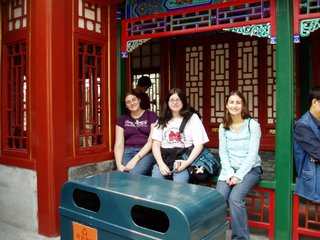
Today we took a trip to the New Summer Palace (Yiheyuan), which is only fifteen or twenty minutes by bus or taxi away from where we live in Beijing at Beijing Foreign Studies University. The Summer Palace we visited, and the one most tourists encounter, is the "New Summer Palace," as opposed to the older one that was, according to my Fodor's "China" guidebook, "looted and systematically blown up byBritish and French soldiers" in 1860 (25). The three guidebooks I'm following ("Let's Go: China," Fodor's "China," and the "Insight City Guide: Beijing") differ in their histories about the Old Summer Palace, so I'm going to forgo discussion of Yuanmingyuan, the older palace now in ruins, until I can sort out what is accurate. The guidebooks agree, however, that the New Summer Palace was its replacement, built in the 1880s and used by the Dowager Empress Cixi. It is stunning and huge, a visual feast, made up of many courtyards, pavillions, long covered corridors that line a lake (we took a boat out to the Seventeen-Arch Bridge) and gardens. Most of it seems to have been recently restored, although we were not able to climb up to the very highest part of the Palace. I'll let the students say more about the Summer Palace and use what they have to say next week, but everyone took stunning photos.
Above you see, as promised, photos of the girls. Here are three of the four, Natalia, Vicky, and Jackie.
Skype Rules
Friday, September 15, 2006
Thursday, September 14, 2006
Why We Travel
The Weekend
My advice for students going out on their own: (1) Hang on to enough money to take a taxi home, even if you get separated from the group. Beijing is really big, but taxis are cheap and plentiful – our ride this weekend in shared taxis was about $2.50 per person for the round trip, and it was a long trip – perhaps 30 minutes each way. (2) Divide your money and carry it in a few places so that in the unlikely event your wallet or purse is lost or stolen you can still get home. (3) Keep something on you – a card or a map – that includes the Chinese characters for where you’re going and for BFSU. As the “Let’s Go” guidebook suggests, almost all taxi drivers carry cell phones, so if you have the phone number of your location (say, a restaurant or a store) the driver can call for directions. As it happened, our three groups did get separated – but two found one another, and everyone had a good time and returned with no problem. Wangfujian is the same area where our hotel was this summer – a world away from Beiwai. Then we stayed in a moderately priced hotel, but lots of very fancy ones are close by; their lobbies, like the lobbies of good hotels all over the world, are semi-public spaces that are excellent places to use a restroom or catch your breath. If you want it, you can find McDonalds and KFC, upstairs in what turns out to be a very glitzy mall. But there are also serious bookstores (our group tried two) featuring some very inexpensive books – I bought a small volume of Chinese poetry in English and Chinese for 10 yuan – and a large pedestrian mall full of all kinds of stores. My roommate this summer, Noor, even tried out the bungee ball across the street from the old Catholic church. I was not as adventurous!
.
The Flight that Never Landed

This is a view of Alaska, taken from the window of a 747 on our flight for the summer trip to China and Japan- our flight actually stretched from June 28 to June 29 (crossing the international dateline) to June 30. Read on to find out why!

This past summer, from June 28 to July 10, three North Central people (Jack Shindler, Kimberly Larsson, and I) and 20 K-12 faculty traveled on a two-week trip to China and Japan. (The photo above is of my intrepid travel rooomate, Noor, who is a fifth-grade teacher.) I was lucky enough to be in the group and get a preview of the countries and schools we’ll be attached to in Asia. The short trip was exhilarating and action-packed; to begin with, we flew, just like the group I’m with now, to Tokyo-Narita airport, had a layover, and boarded another Japan Airlines flight to Beijing. But that flight in June never landed in Beijing; when we reached airspace over the capital, thunderstorms had closed the airport and we circled for about forty-five minutes. When that time was up, the pilot announced that Beijing Airport was still closed, so we were flying to ---- Osaka-Kansai! Since we had already been up for more than 24 hours, and our itinerary was jam-packed with activities, we weren’t sure what this meant. In fact, a week later we were supposed to go to Osaka, but arriving a week early wouldn’t help. But we were about to get the Japan Airlines treatment.
When we landed in Kansai, they had air-conditioned buses ready for us, and uniformed JAL staffers bowed to us in apology for the inconvenience. The buses delivered us to the Swisshotel in Osaka, fifty minutes away. Swisshotel or JAL must have called in extra staff to handle the busloads of people who arrived. We were quickly assigned rooms that turned out to be luxurious, way more expensive than the kind we expected to stay in for the rest of the trip. There were bathrobes and slippers and the famous Toto Japanese toilets with heated seats and mysterious water sprays. We were also given coupons for breakfast. Grateful for the comfortable beds, we were sorry we had only four hours to sleep before breakfast and a bus back to the airport. Breakfast was just as luxurious – it included Japanese and western-style food, and we wolfed down smoked salmon, fresh fruit, eggs, croissants, and wonderful coffee. Then it was onto the bus, and to the airport, where we were met by more Japan Airlines staff that guided us through the airport, carrying signs on sticks and handing us off in relays until we got to the right spot. By that afternoon we were touring the Forbidden City in Beijing. I was almost sorry that our flight on this trip actually landed in Beijing on time. Moral: if you’re diverted, make sure you’re flying an airline like JAL. But this trip, with 12 students, was uneventful and we landed just when we were supposed to. Anyone else have good rerouting stories?
Sunday, September 10, 2006
The Great Wall at Mutianyu
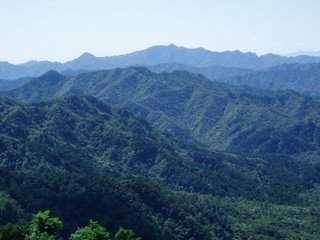


We had a fantastic trip to the Great Wall at Mutianyu. I have also been to Badaling, which was great, but it was a zillion degrees and I am the world's worst hiker. I took the easy way out (as long as you're not afraid of heights): along with some students, I took the gondola (just like a ski lift) up and the toboggan down. The toboggan is a small plastic sled with a brake and you ride it down a metal chute, much like a big waterslide, but a lot slower. The day was pure and clear, the sunlight bright, the temperature cool. We could not have ordered a more perfect day. Although it's famous for what the guidebooks call a "strenuous hour-long climb" up steep steps, the students who climbed found it easy. When you get to the ramparts, you can walk along them from turret to turret. Note the crookedness of some of the steps!
Bare Feet on a Plane

Not snakes, but a little scary looking. The man seating in front of me on August 31 had a little too much to drink and didn't feel well, so he stretched out over three seats. I'm short enough that nothing sticks out when I do that, but he was quite a bit taller. As far as I could see everyone, especially the flight attendants, politely veered around the protruding feet.
Thursday, September 07, 2006
Rich in China
Tuesday, September 05, 2006
Travel Writing
Iyer, in a "Salon" essay from March 2000, without mentioning Fussell by name, refers to the controversy about tourists and travelers:
"We travel, initially, to lose ourselves; and we travel, next, to find ourselves. We travel to open our hearts and eyes and learn more about the world than our newspapers will accommodate. We travel to bring what little we can, in our ignorance and knowledge, to those parts of the globe whose riches are differently dispersed. And we travel, in essence, to become young fools again -- to slow time down and get taken in, and fall in love once more. The beauty of this whole process was best described, perhaps, before people even took to frequent flying, by George Santayana in his lapidary essay, "The Philosophy of Travel." We "need sometimes," the Harvard philosopher wrote, "to escape into open solitudes, into aimlessness, into the moral holiday of running some pure hazard, in order to sharpen the edge of life, to taste hardship, and to be compelled to work desperately for a moment at no matter what."
He continues: "If a Mongolian restaurant seems exotic to us in Evanston, Ill., it only follows that a McDonald's would seem equally exotic in Ulan Bator -- or, at least, equally far from everything expected. Though it's fashionable nowadays to draw a distinction between the 'tourist' and the "traveler," perhaps the real distinction lies between those who leave their assumptions at home, and those who don't: Among those who don't, a tourist is just someone who complains, 'Nothing here is the way it is at home,' while a traveler is one who grumbles, 'Everything here is the same as it is in Cairo -- or Cuzco or Kathmandu.' It's all very much the same."
It's a beautiful essay, and I've suggested to the students that if they feel uninspired this essay can prompt any number of responses. Is it somehow less virtuous to go to McDonalds in Fez or Beijing? (I've been to both: in Fez it's a place to take a date, decorated with a painted Berber-style ceiling, offering the McArabia sandwich; in Beijing it's a place to meet other Americans and eat miniature versions of the shake and the burger.) Of course it's not the act of going to McDonalds - it's what that means. Take a look at Iyer's essay. He has a lot to say.
Monday, September 04, 2006
We're in China!!
We're doing okay - everyone has found something to eat; we have been to a few convenience stores; we're waiting patiently for our ID cards so we can get Internet in the rooms. There's an Interet place in the building, which charges, but it inexpensive. We had our first Chinese class today, taught by an energetic young woman, and a Tai Chi class on the patio outside, taught by an equally energetic 74-year old man. For the next class I suggest we not choose something which doubles as a parking lot. Someone's backpack was run over but the camera and watch inside emerged unscathed. The rooms seem to be fine - and we just need to learn how to do everything. We want to meet some Chinese students whom we can speak to and who can show us around. There do seem to be a lot of European students, and we have met some Americans as well.



